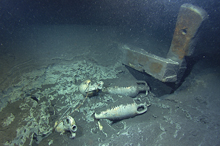
Discovered off the coast of Turkey at about 340-meter depth, Sinop D is the most well-preserved ancient shipwreck found in the Black Sea. Intense investigation began in 2003, and we plan to return to Sinop D in 2007. Our plan is to characterize the environment in which the Sinop D wreck rests, to see how the site has changed in the last four years, and to compare its preservation with another Byzantine shipwreck, Chersonesos A, which lies in shallower water off the coast of Ukraine. Click image for larger view and image credit.
Aegean and Black Sea Expedition 2007
Mission PlanKatherine Croff
Chief Scientist – Aegean and Black Sea Expedition 2007
PhD Student –
Graduate School of Oceanography
University of Rhode Island
Catalina Martinez
Regional Manager – NOAA Office of Ocean Exploration
The 2007 Aegean and Black Sea Expedition consists of three distinct projects: a geological study in the Sea of Crete, an archaeological survey and shipwreck excavation off the coast of Ukraine in the Black Sea, and an archaeological investigation of a well-preserved shipwreck off Turkey in the Black Sea. In addition to the scientific objectives, our expedition members will test new technologies on board the new NOAA ship Okeanos Explorer.
This expedition is led by the University of Rhode Island (URI), Institute for Exploration (IFE), and the NOAA Office of Ocean Exploration (OE). We will work on board the NRV Alliance, a 93-meter research vessel based in La Spezia, Italy, and the Flamingo, a Ukrainian research vessel. Our team of oceanographers, geologists, archaeologists, and engineers will use the remotely operated vehicles (ROVs) Hercules, Argus, and Echo, owned and operated by IFE and URI.
Expedition Science Objectives
The Sea of Crete, located in the southern Aegean Sea, is one of the most tectonically active regions of the Mediterranean. Volcanic eruptions, earthquakes, and tsunamis are a few of the physical processes that occur in this area because of the subduction of the African plate under the Eurasian plate. The Thera and Sea of Crete projects carried out in 2006 revealed evidence of sediment movement on the submarine slopes of the Santorini volcano and Sea of Crete basin. We will return to this area to further investigate the history of these processes that is locked in the sea-floor sediments of the Sea of Crete.
Two Byzantine shipwrecks discovered in recent years off the coasts of Ukraine and Turkey — Chersonesos A and Sinop D — will be investigated in detail. Our goal here is to characterize the environment (geologically, physically, chemically, and biologically) and to study the preservation of archaeological material in the suboxic and anoxic waters of the Black Sea, where there is very little oxygen. We plan to carry out the following: baseline surveys of the initial environmental conditions at each site; ongoing environmental monitoring to anticipate and mitigate any adverse environmental effects due to excavation; an assessment of the natural and man-made risks facing each archaeological site; and an analysis on how the wreck sites can be used for studying the surrounding environment. In addition to our scientific results and findings, we hope this project will help further knowledge about in situ (on site) preservation of archaeological material for the development of underwater museums.
While the work on these shipwrecks is carried out aboard NRV Alliance, a team on Flamingo will carry out an autonomous underwater vehicle (AUV) survey of the area surrounding Chersonesos A and areas west, collecting side scan sonar as well as conductivity, temperature, depth, and dissolved oxygen data. The primary purpose is to collect data that will help us understand more about the dynamic oceanographic processes related to breaking internal waves that locally redistribute anoxic bottom water to shallower depths. These processes create interesting sedimentary bedforms and produce a temporally varying anoxic environment at depths typically thought to be oxygenated.
Testing and development: Preparing for the new NOAA ship Okeanos Explorer
In 2008, NOAA will commission a ship of exploration, the Okeanos Explorer. This unique ship is currently undergoing extensive conversion in Seattle, and once complete, will be the only Federal vessel dedicated to exploring little known and unknown reaches of our world’s ocean. The Okeanos Explorer will serve three primary missions: 1) deep-water mapping (to 6,000 m depth); 2) science class remotely operated vehicle (ROV) operations; and 3) real-time broadband satellite transmission of data. Installation of a satellite system on the ship will allow shore-based access to data and information in real-time for scientific exploration and educational outreach purposes.
NOAA OE is poised to initiate a major scientific and public outreach program from this new dedicated research vessel. The program will include the use of telepresence technology to allow expeditions to be managed "virtually" by scientists working from shore, and to share the excitement of discovery with students, teachers, and the general public in real-time through a variety of outreach and education efforts. Telepresence technology uses satellite technology and Internet2 to transmit data and video in real-time from ROVs (working at depth) to a shore-based hub located at URI. The hub then sends this data to Exploration Command Centers and a variety of other receiving stations on shore.
Development and testing of the software and systems, as well as operating protocols associated with the use of this new technology, have been ongoing for several years through collaboration between NOAA OE, URI, and IFE. The Aegean and Black Sea expedition will serve as a test platform for many of these efforts as we continue to work together to refine process and protocol for the use of telepresence technology on the new NOAA ship Okeanos Explorer in 2008 — and beyond. Stay tuned!





